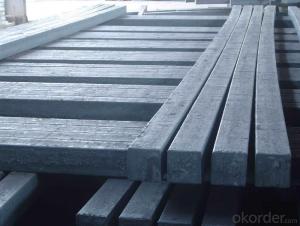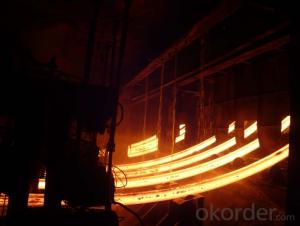Square Steel Billet Q235 3SP Grade Prime Quality 2#
- Loading Port:
- Tianjin
- Payment Terms:
- TT OR LC
- Min Order Qty:
- 2000 m.t
- Supply Capability:
- 50000 m.t/month
OKorder Service Pledge
OKorder Financial Service
You Might Also Like
Description of Square Steel Billet Q235 3SP Grade Prime Quality 2#
M. S. Billets are used for rolling of TMT Re-Bars of Fe415 and Fe500 Grade and various other structural steel products.
CRS Billets are used for rolling of CRS TMT Re-Bars.
Special Alloy Billets are used for rolling of any special grade TMT Re-Bars like Earthquake resistant TMT Re-Bars and for special grade structural steel products.
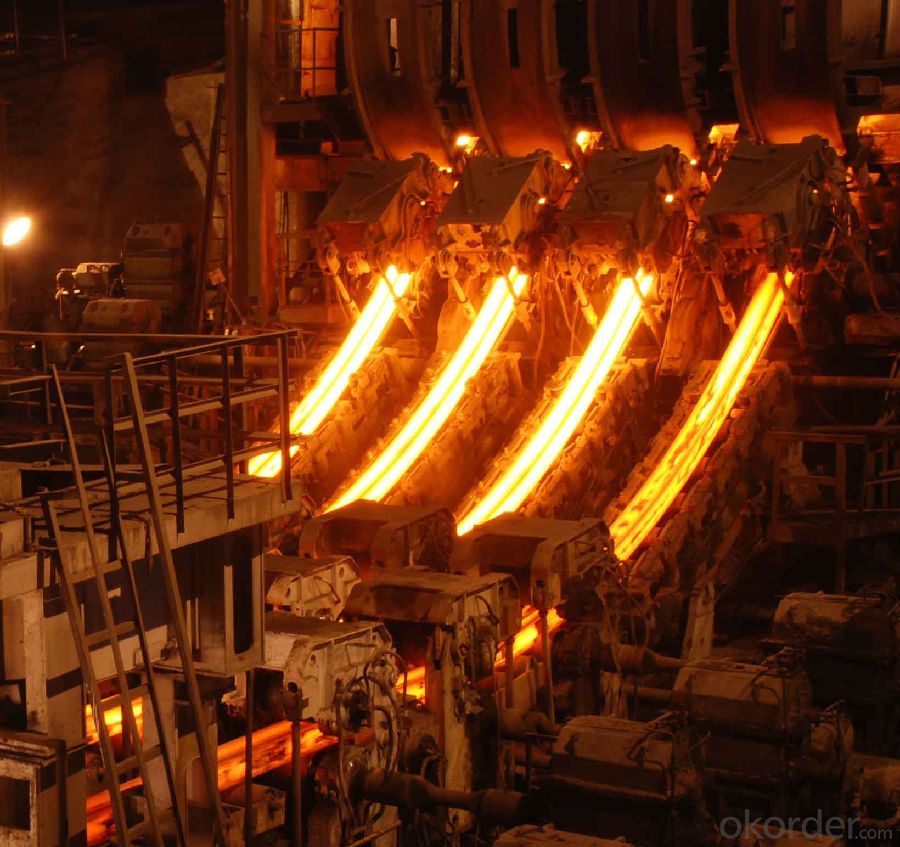
Main Feature Square Steel Billet Q235 3SP Grade Prime Quality 2#
Raw elements(C,Fe,Ni,Mn,Cr,Cu.)---Smelted ingots by AOD finery---hot rolled into black suface---pickling in acid liquid---cold drawn----polished by automatically machine--- cutting into pieces---checking quanlity
Applications of Square Steel Billet Q235 3SP Grade Prime Quality 2#
Widely Used in the areas such as Stainless Steel Fasteners, Chains, Kitchen and Sanitary wares, Furniture handles, Handrails, Electroplating and Electrolyzing pendants, Foods, Electron, Petroleum, Construction and Decoration, etc. Products have a high strength after cold-working. Electronic products parts, Medical appliance, Springs, Bus Inside and Outside packaging and building, Street Lamp Posts, etc. Decoration materials and Outdoor Publicity Billboard. Used for the products which have the Anti-Stress Corrosion requirement. Electron Products, Table-wares, Bolts, Nuts, Screen Meshes, Cumbustors and so on.
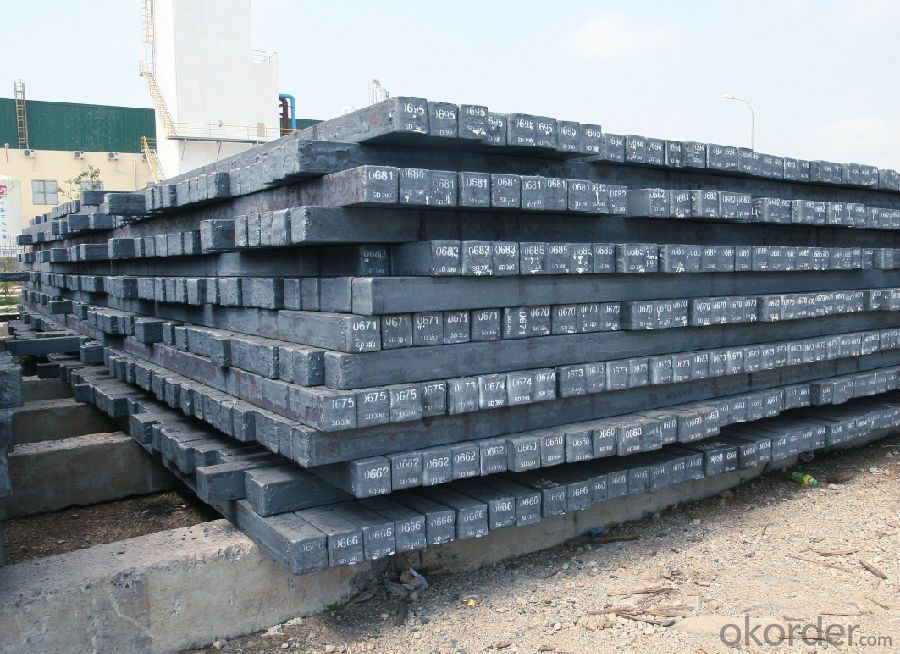
Specifications of Square Steel Billet Q235 3SP Grade Prime Quality 2#
| Standard | C(%) | Mn(%) | S(%) | P(%) | Si(%) |
| Q195 | ≤0.12 | ≤0.50 | ≤0.040 | ≤0.035 | ≤0.30 |
| Q235 | ≤0.20 | ≤1.40 | ≤0.045 | ≤0.045 | ≤0.35 |
| Q275 | ≤0.22 | ≤1.50 | ≤0.045 | ≤0.045 | ≤0.35 |
| 20MnSi | 0.17-0.25 | 1.2-1.6 | ≤ 0.050 | ≤ 0.050 | 0.40-0.80 |
| 3SP | 0.14-0.22 | 0.40-0.85 | ≤ 0.050 | ≤ 0.040 | 0.05-0.15 |
| 5SP | 0.28-0.37 | 0.50-1.00 | ≤ 0.050 | ≤ 0.040 | 0.15-0.30 |
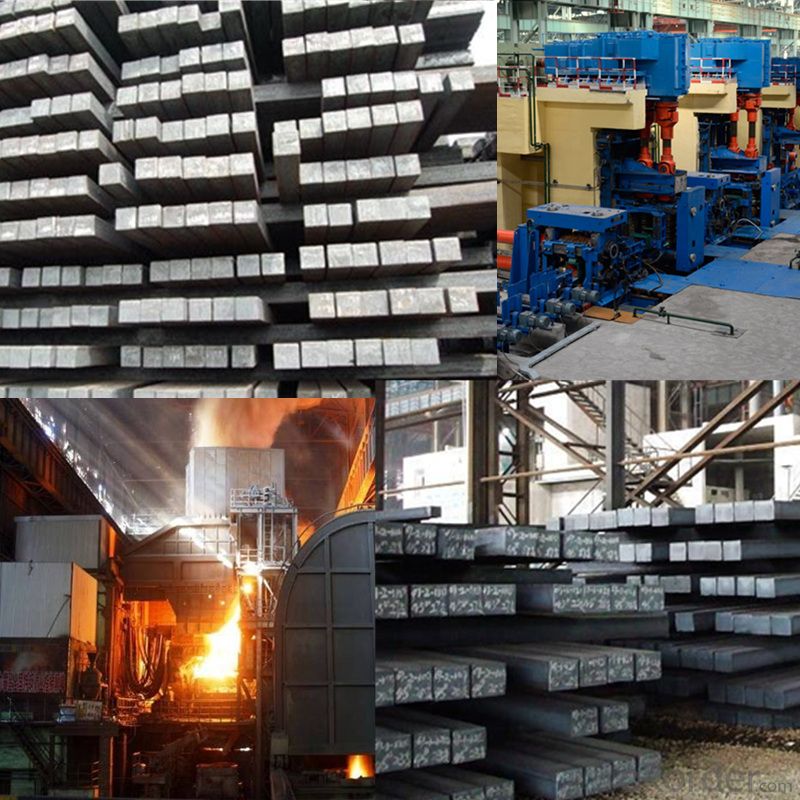
FAQ of Square Steel Billet Q235 3SP Grade Prime Quality 2#
We have organized several common questions for our clients,may help you sincerely:
1. How Can I Visit There?
Our company is located in Tianjin City, China, near Beijing. You can fly to Tianjin Airport Directly. All our clients, from home or aboard, are warmly welcome to visit us!
2. How Can I Get Some Sample?
We are honored to offer you sample.
3. Why choose CNBM?
Our delivery time about 15-20days for standard sizes, if you have other requirements like hardness, quanity and width ,it is about 20-40days. But don't worry we also try our best for the delivery time ,because time longer and our cost is higher.
- Q:What are the different surface treatments applied to steel billets?
- There are several surface treatments that can be applied to steel billets. Some common treatments include hot-dip galvanizing, electroplating, powder coating, and painting. These treatments help to protect the steel from corrosion, improve its appearance, and enhance its durability. Additionally, surface treatments can also be used to provide specific characteristics such as increased hardness or improved resistance to wear and tear.
- Q:What is the standard size of a steel billet?
- The standard size of a steel billet can vary depending on its intended use and industry standards. However, common sizes range from 5 inches by 5 inches to 10 inches by 10 inches, with varying lengths.
- Q:What are the different surface treatments for improved dimensional accuracy in steel billets?
- There are several surface treatments that can be employed to enhance dimensional accuracy in steel billets. These treatments aim to reduce surface imperfections, improve surface finish, and minimize dimensional variations. Some common surface treatments for improved dimensional accuracy in steel billets include: 1. Shot blasting: This process involves propelling abrasive particles at high velocity onto the surface of the billet. Shot blasting removes any dirt, scale, or surface contaminants, resulting in a smoother and cleaner surface. This treatment helps to eliminate any potential dimensional variations caused by surface irregularities. 2. Peeling: Peeling is a machining process in which a thin layer of material is removed from the surface of the billet using a cutting tool. This treatment helps to eliminate surface defects and imperfections, resulting in improved dimensional accuracy. Peeling can also enhance the surface finish of the billet. 3. Grinding: Grinding is a process in which an abrasive wheel or belt is used to remove material from the surface of the billet. This treatment helps to remove any surface irregularities, such as high spots or scratches, resulting in improved dimensional accuracy. Grinding can also provide a smoother and more uniform surface finish. 4. Turning: Turning is a machining process in which a cutting tool is used to remove material from the surface of the billet. This treatment helps to achieve precise dimensions and surface finish. Turning can also be used to improve concentricity and straightness of the billet. 5. Polishing: Polishing involves using abrasive materials or compounds to create a smooth and reflective surface on the billet. This treatment helps to remove any surface imperfections, such as scratches or blemishes, resulting in improved dimensional accuracy and surface finish. It is important to note that the choice of surface treatment may vary depending on the specific requirements and desired outcomes. Manufacturers often employ a combination of these treatments to achieve optimal dimensional accuracy in steel billets.
- Q:How do steel billets contribute to the circular economy?
- Steel billets contribute to the circular economy in several ways. Firstly, they are a key component in the recycling process of steel. Steel is one of the most recycled materials in the world, and the use of steel billets enables the recycling of scrap steel into new products. By using steel billets, the steel industry can reduce the demand for virgin iron ore and the energy-intensive processes associated with its extraction and production. Moreover, steel billets can be produced from various sources, including industrial waste, automotive scrap, and construction waste. This allows for the repurposing of materials that would otherwise end up in landfills, reducing waste and conserving resources. By utilizing steel billets made from recycled materials, the industry can promote a more sustainable and environmentally friendly approach to steel production. Furthermore, steel billets are highly versatile and can be used in a wide range of applications. This versatility extends the lifespan of steel products and reduces the need for replacement. In the circular economy, the aim is to maximize the use of resources, and steel billets contribute to this goal by enabling the production of durable and long-lasting steel products. Lastly, the circular economy emphasizes the importance of closing the loop and ensuring that materials are reused or recycled at the end of their life cycle. Steel billets facilitate this process by being a readily available feedstock for the production of new steel products. This not only reduces the reliance on virgin materials but also minimizes the environmental impact associated with extracting and processing raw materials. In conclusion, steel billets play a crucial role in the circular economy by enabling the recycling of steel, repurposing of waste materials, promoting durability, and closing the loop in the steel production process. Their use contributes to the conservation of resources, reduction of waste, and overall sustainability of the steel industry.
- Q:How are steel billets used in the manufacturing of tools?
- The production of tools relies on the use of steel billets, which serve as the starting material. Steel billets are semi-finished products that have a square or rectangular shape and are made of solid steel. They are created through a process called steelmaking, which involves melting iron ore to produce steel. To manufacture tools, the steel billets undergo a preliminary step of heating to a specific temperature known as the forging temperature. At this temperature, the steel becomes flexible and can be easily shaped. The billets are then shaped using various forging techniques, including hammering, pressing, or rolling, until they take on the desired form of the tool. Once the billets have been forged into the desired shape, they undergo further processing through machining operations. These operations, such as milling, drilling, grinding, or turning, are used to achieve the required dimensions and surface finish. Excess material is removed during this stage, and the tool's shape and features are refined. After the machining process, the tools undergo heat treatment to enhance their mechanical properties. This involves subjecting the tools to specific heating and cooling cycles, which alter their hardness, toughness, and resistance to wear. This step is crucial in ensuring that the tools can withstand the demanding conditions they will encounter during use. Finally, the tools are given a finishing touch and coating to provide protection against corrosion and improve their appearance. This can involve processes such as sandblasting, polishing, and the application of protective coatings like chrome plating or powder coating. In conclusion, steel billets play a vital role in the manufacturing of tools, serving as the raw material that undergoes forging, machining, heat treatment, and finishing. The properties of the steel billets, such as their composition and metallurgical characteristics, contribute significantly to the final quality, strength, and durability of the tools produced.
- Q:What are the key factors driving the demand for steel billets?
- There are several key factors driving the demand for steel billets. Firstly, the construction industry plays a significant role in boosting the demand for steel billets. Steel is widely used in construction projects for various purposes, such as structural framing, reinforcement, and support systems. As urbanization continues to grow and infrastructure projects increase, the demand for steel billets also rises. Additionally, the automotive industry is a major driver of steel billet demand. Steel is a crucial material in the manufacturing of automobiles, including car bodies, chassis, and engine components. As the global automotive industry expands and consumers demand more vehicles, the demand for steel billets increases accordingly. Moreover, the energy sector contributes to the demand for steel billets, particularly in the production of oil and gas pipelines. Steel billets are used to manufacture seamless pipes, which are essential for the transportation of oil and gas over long distances. As the demand for energy continues to rise, so does the need for steel billets to support pipeline construction. Furthermore, the manufacturing and machinery industries rely heavily on steel billets. From industrial machinery to consumer products, steel is a fundamental material used in various manufacturing processes. As these industries grow and evolve, the demand for steel billets remains steady. Lastly, the global economic growth and industrialization in emerging markets have a significant impact on the demand for steel billets. Countries with rapidly developing economies, such as China and India, are major consumers of steel billets as they undergo massive infrastructure projects and industrial expansion. Overall, the demand for steel billets is primarily driven by the construction industry, automotive sector, energy sector, manufacturing industry, and global economic growth. These factors collectively contribute to the sustained and growing demand for steel billets in the market.
- Q:Are steel billets used in the manufacturing of industrial machinery?
- Commonly used in the manufacturing of industrial machinery are steel billets. These semi-finished products are typically produced through continuous casting. They serve as the raw material for various types of machinery, including heavy-duty equipment, construction machinery, and machine tools. Industrial machinery prefers steel due to its strength, durability, and resistance to wear and tear. Steel billets often serve as the starting material for processes such as forging, rolling, or machining to create specific components required for machinery. These components encompass gears, shafts, frames, brackets, and other structural parts. Steel possesses high-quality properties, including high tensile strength and excellent mechanical properties, making it an ideal material for enduring demanding conditions and heavy loads in industrial machinery. Furthermore, steel's easy weldability and machinability allow manufacturers to produce intricate and precise parts for machinery. In summary, steel billets play a vital role in the manufacturing of industrial machinery. They provide the necessary raw material to create robust and dependable components capable of withstanding the challenges posed by various industrial applications.
- Q:What are the different types of steel billet casting processes?
- There are several different types of steel billet casting processes, including continuous casting, semi-continuous casting, and ingot casting. Continuous casting involves the continuous pouring of molten steel into a water-cooled mold, allowing for a continuous production process. Semi-continuous casting, on the other hand, involves the periodic pouring of molten steel into individual molds, resulting in intermittent production. Ingot casting is a traditional method where molten steel is poured into a stationary mold, allowing it to solidify into a solid block or ingot shape. These different casting processes offer various advantages and are utilized based on the specific requirements of the steel production industry.
- Q:Can steel billets be used in the production of bicycles?
- Certainly! Bicycles can indeed utilize steel billets in their production. Steel billets, which are partially finished products derived from steel, can undergo further processing to attain a wide range of shapes and sizes. When it comes to bicycles, these steel billets can be molded and fashioned into diverse components such as frames, forks, handlebars, and other structural elements. Steel remains a popular choice for bicycle production due to its commendable attributes of strength, durability, and cost-effectiveness. It offers exceptional rigidity, stability, and resistance to deformation, rendering it suitable for various bicycle types including road bikes, mountain bikes, and hybrid bikes. Furthermore, steel can be readily welded, enabling customization and facilitating the repair of bicycle frames.
- Q:How are steel billets used in the production of turbine blades?
- Steel billets are an integral component in the production of turbine blades. These billets, which are essentially semi-finished steel products, serve as the starting material for the manufacturing process. To begin with, steel billets are carefully selected based on specific requirements such as composition, strength, and durability. Once chosen, they undergo a series of processing steps to shape them into turbine blades. The first step involves heating the steel billets to high temperatures in a furnace. This process, known as forging, makes the steel more malleable and easier to work with. Once heated, the billets are then subjected to mechanical forces that shape them into the desired form of turbine blades. After the initial forging process, the turbine blades are further refined through various machining operations. This includes precision cutting, grinding, and drilling to achieve the required dimensions, surface finish, and aerodynamic profiles. In addition to shaping and refining, steel billets also play a crucial role in enhancing the strength and integrity of turbine blades. Through heat treatment processes such as quenching and tempering, the billets are hardened and tempered to achieve the desired mechanical properties, such as high strength and resistance to fatigue. Furthermore, steel billets provide the necessary material properties to withstand the harsh operating conditions of turbines. They offer excellent corrosion resistance, which is essential for blades operating in environments exposed to high temperatures, pressure, and moisture. Overall, steel billets are essential in the production of turbine blades as they provide the starting material, allow for shaping and refinement, and offer the necessary strength and durability required for these critical components in power generation.
1. Manufacturer Overview |
|
|---|---|
| Location | |
| Year Established | |
| Annual Output Value | |
| Main Markets | |
| Company Certifications | |
2. Manufacturer Certificates |
|
|---|---|
| a) Certification Name | |
| Range | |
| Reference | |
| Validity Period | |
3. Manufacturer Capability |
|
|---|---|
| a)Trade Capacity | |
| Nearest Port | |
| Export Percentage | |
| No.of Employees in Trade Department | |
| Language Spoken: | |
| b)Factory Information | |
| Factory Size: | |
| No. of Production Lines | |
| Contract Manufacturing | |
| Product Price Range | |
Send your message to us
Square Steel Billet Q235 3SP Grade Prime Quality 2#
- Loading Port:
- Tianjin
- Payment Terms:
- TT OR LC
- Min Order Qty:
- 2000 m.t
- Supply Capability:
- 50000 m.t/month
OKorder Service Pledge
OKorder Financial Service
Similar products
New products
Hot products
Related keywords


